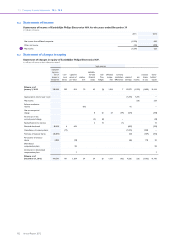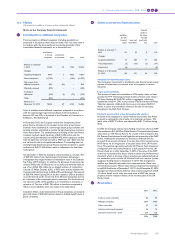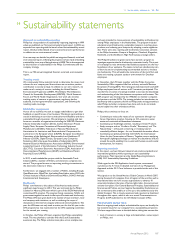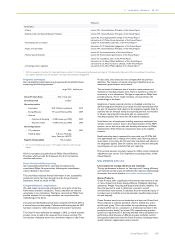Philips 2012 Annual Report Download - page 189
Download and view the complete annual report
Please find page 189 of the 2012 Philips annual report below. You can navigate through the pages in the report by either clicking on the pages listed below, or by using the keyword search tool below to find specific information within the annual report.
14 Sustainability statements 14 - 14
Annual Report 2012 189
Reference1)
Governance
- Privacy section 14.4, General Business Principles, of this Annual Report
- Business ethics and General Business Principles section 14.4, General Business Principles, of this Annual Report
- Partnerships and co-creation
section 4.2, Encouraging positive change, of this Annual Report
sub-section 6.4.1, Philips Group Innovation, of this Annual Report
chapter 14, Sustainability statements, of this Annual Report
- Impact of social media
sub-section 5.2.9, Stakeholder engagement, of this Annual Report
section 14.4, General Business Principles, of this Annual Report
- Metrics beyond financials
section 5.2, Social performance, of this Annual Report
section 5.3, Environmental performance, of this Annual Report
- Increasing product regulation
section 7.5, Compliance risks, of this Annual Report
sub-section 6.1.3, About Philips Healthcare, of this Annual Report
sub-section 6.2.3, About Consumer Lifestyle, of this Annual Report
sub-section 6.3.3, About Philips Lighting, of this Annual Report
1) With the exception of section 5.2, Social performance, section 5.3, Environmental performance, and chapter 14, Sustainability statements, of this Annual Report, the sections
and chapters referred to are not included in the scope of the assurance engagement
Programs and targets
Our sustainability commitments are grouped under the label EcoVision,
comprising the following elements:
target 2015 baseline year
Green Product Sales 50% of total sales
Lives Improved 2 billion
Green Innovation
- Investments EUR 2 billion (cumulative) 2010
- Energy Efficiency 49 Lumen/Watt (up 50%) 2009
- Materials
- Collection & Recycling 74,000 tonnes (up 100%) 2009
- Recycled content 15,000 tonnes (up 100%) 2009
Green Operations
- CO2 reduction 40% 2007
- Health & Safety 0.26 Lost Workday
Injury Cases per 100 FTE
Supplier Sustainability1) 72% compliant
1) For more information see section 14.5, Supplier indicators, of this Annual
Report
All of our programs are guided by the Philips General Business
Principles, which provide the framework for all of our business
decisions and actions.
Scope of sustainability reporting
Our sustainability performance reporting encompasses the
consolidated Philips Group activities, following the consolidation
criteria detailed in this section.
The consolidated selected financial information in this sustainability
statements section has been derived from the Group Financial
Statements, which are based on IFRS.
Comparability and completeness
We used expert opinions and estimates for some parts of the Key
Performance Indicator calculations. There is therefore an inherent
uncertainty in our calculations. The figures reported are Philips’ best
possible estimate. As our insight increases, we may enhance the
methodology in the future.
Lives improved by Healthcare have been restated for 2010 and 2011 as
a result of improved data quality. Collection and Recycling data for 2011
has been restated to reflect the inclusion of Consumer Luminaires.
The Green Product definition has changed in 2012 to include absolute
product norms as well as the revenues from remote servicing. The
introduction of absolute norms has a downward impact on the Green
Product sales, since these are more stringent than the previous
definition. The inclusion of remote servicing in Healthcare has an
immaterial upward impact on the trend.
The emissions of substances data is based on measurements and
estimates at manufacturing site level. There is therefore an inherent
uncertainty in our calculations. The figures reported are Philips' best
possible estimate. As our insight increases, we may enhance the
methodology in the future.
Integration of newly acquired activities is scheduled according to a
defined integration timetable (in principle, first full reporting year after
the year of acquisition) and subject to the integration agenda. Data for
activities that are divested during the reporting year are not included
in full-year reporting. Environmental data are measured for
manufacturing sites with more than 50 industrial employees.
Social data cover all employees, including temporary employees, but
exclude contract workers. Due to the implementation of new HRM
systems, we are able to provide exit diversity information on Philips
employees for 2012. Historical comparisons may not be available,
however.
Health and safety data is measured for units with over 50 FTEs (full-
time equivalents) and is voluntary for smaller units. New acquisitions
must report, in principle, the first year after acquisition and subject to
the integration agenda. Data for activities that are divested during the
reporting year are not included in full-year reporting.
Prior periods amounts have been revised to reflect certain immaterial
adjustments (see section 12.10, Significant accounting policies, of this
Annual Report).
Data definitions and scope
Lives improved, energy efficiency and materials
The key performance indicators on ‘lives improved’, ‘energy efficiency’
and ‘materials’ and the scope are defined in the respective methodology
documents that can be found at www.philips.com/sustainability.
Green Products
Green Products offer a significant environmental improvement in one
or more Green Focal Areas: Energy efficiency, Packaging, Hazardous
substances, Weight, Recycling and disposal and Lifetime reliability. The
life cycle approach is used to determine a product’s overall
environmental improvement. It calculates the environmental impact of
a product over its total life cycle (raw materials, manufacturing, product
use and disposal).
Green Products need to prove leadership in at least one Green Focal
Area compared to industry standards, which is defined by a sector
specific peer group. This is done either by outperforming reference
products (which can be a competitor or predecessor product in the
particular product family ) by at least 10%, outperforming product-
specific eco-requirements or by being awarded with a recognized eco-
performance label. Because of different product portfolios, sectors
have specified additional criteria for Green Products, including product-
specific minimum requirements where relevant.
























